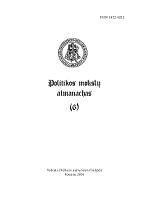Lojalių vartotojų galimos pakeitimo elgsenos formavimosi modelis
THE MODEL OF FORMATION OF POTENTIAL SWITCHING BEHAVIOR OF LOYAL CUSTOMERS
Author(s): Kristina ZikienėSubject(s): Economy
Published by: Vytauto Didžiojo Universitetas
Keywords: vartotojų lojalumas; pakeitimo elgsena; pakeitimo elgseną iššaukiantys veiksniai; pakeitimo elgseną stabdantys veiksniai; customer loyalty; switching behaviour; factors supporting customer switching behaviour; factors repressing customer switching behavio
Summary/Abstract: Building relationships with customers often becomes the activity that further guarantees successful competition for the organization in the ever-changing business world. Different scientists acknowledge customer relationship to be of benefit for organizations on a long-term basis by emphasizing economic and non-economic benefits resultant from customer loyalty. However, the analysis of practical examples shows, that customer loyalty is not a static, but changeable. However, the importance of customer loyalty for business organizations induces further scientific discussion regarding the topic of customer retention: scientists are constantly searching for new ways enabling companies to control customer switching behaviour. It is no coincidence that customer loyalty studies presented in scientific literature recently have started focusing on the process of ending relationship between the customer and companies with the aim to reveal reasons existing behind the customer decision to end his/her relationship with the company. The analysis of relationship ending as of the outcome of behavioural disloyalty is assumed to lead to significant insight regarding issues of customer loyalty management and to help avoid potential loss of customers. Customers’ decision to change companies is influenced by many factors. The analysis of scientific literature shows that different factors affecting customer switching behaviour exist, and they are often dependent on industry, individual sector or business specifics. Depending on the effect, the factors that affect customer switching behaviour are divided into those supporting (loyalty repressing factors) and repressing switching behaviour (loyalty supporting factors). The evaluation of presumptions of customer loyalty and the customer switching behaviour formation as well as the establishment of functional links between customer loyalty and switching behaviour variables enables to form the model of formation of potential switching behaviour of loyal customers. The model of formation of potential switching behaviour of loyal customers could help companies in establishing customer-specific factors that affect potential switching behaviour of their loyal customers and, moreover, it could help to foresee the factors’ influence on the possible occurrence of switching behaviour. Knowing customer-specific factors that affect potential switching behaviour of their loyal customers, organizations could reduce the probability of occurrence of loyal customer switching behaviour, find new ways to prevent customers’ turnover and make better targeted decisions regarding loyalty building.
Journal: Organizacijų vadyba: sisteminiai tyrimai
- Issue Year: 2010
- Issue No: 53
- Page Range: 127-142
- Page Count: 16
- Language: Lithuanian

